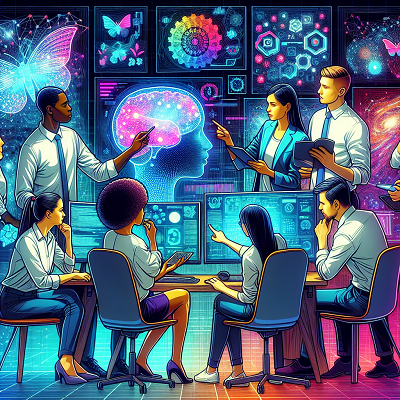In the rapidly evolving landscape of technology, machine learning (ML) stands out as a beacon of innovation, driving advancements across countless industries. However, the magic of ML doesn’t solely reside in algorithms or data; it thrives on the collaborative efforts of diverse teams. This blog delves into the essence of teamwork in ML projects, the core features of ML platforms that promote collaboration, real-world case studies, challenges, and the bright future of collaborative machine learning.
The Essence of Collaboration in Machine Learning
At the heart of every successful ML project lies a team that brings together a myriad of perspectives, skills, and insights. The critical role of teamwork cannot be overstated; it’s the fuel that powers the engine of innovation. Diverse teams leverage their varied backgrounds to tackle problems from multiple angles, leading to more creative solutions and breakthroughs. This synergy is not just beneficial but essential in the complex and multifaceted world of machine learning.
Core Features of ML Platforms Promoting Collaboration
To harness the full potential of teamwork, ML platforms have evolved to offer features that facilitate seamless collaboration. Two key components stand out:
- Shared Workspaces and Version Control: These features allow team members to integrate their work effortlessly, ensuring that everyone is on the same page. Version control, in particular, is crucial for tracking changes and maintaining a coherent development process.
- Communication Tools: Real-time discussions and feedback are pivotal in the fast-paced environment of ML projects. Communication tools embedded within ML platforms enable instant sharing of ideas and prompt resolution of issues, keeping the project momentum going.
Case Studies: Collaboration in Action
The theoretical benefits of collaboration in ML are compelling, but real-world examples truly illustrate its impact. Numerous projects have achieved remarkable success thanks to collaborative efforts facilitated by ML platforms. For instance, a team of data scientists and engineers working on an image recognition project credited the integrated communication tools for their swift problem-solving and innovation pace. These stories not only highlight the practical advantages of collaboration but also offer insights and inspiration for teams embarking on their ML journeys.
Overcoming Challenges in Collaborative Environments
Collaboration, while beneficial, is not without its hurdles. Teams often encounter obstacles such as misalignment on project goals, communication breakdowns, and conflicts. Overcoming these challenges requires a proactive approach:
- Conflict Resolution: Establishing clear protocols for addressing disagreements ensures that conflicts are resolved constructively, keeping the project on track.
- Maintaining Project Alignment: Regular check-ins and updates help in aligning the team’s efforts with the project’s objectives, minimizing deviations and misunderstandings.
Adopting these strategies fosters an environment where collaboration can flourish, even in the face of challenges.
The Future of Collaborative Machine Learning
Looking ahead, the landscape of collaborative ML is set to become even more dynamic. Emerging trends and tools promise to further enhance teamwork capabilities. Innovations such as more sophisticated version control systems, AI-driven collaboration suggestions, and enhanced data sharing mechanisms are on the horizon. These advancements have the potential to revolutionize how teams work together on ML projects, making collaboration more efficient, effective, and enjoyable.
The impact of improved collaboration extends beyond individual projects or teams; it has the power to accelerate the entire field of machine learning. As collaboration becomes more streamlined and integrated into ML platforms, we can expect to see a surge in innovation, pushing the boundaries of what’s possible in technology and beyond.
In conclusion, the collaborative power of ML platforms is a game-changer in the realm of machine learning. By uniting minds and fostering teamwork, these platforms are not just facilitating the development of innovative solutions; they are shaping the future of technology. As we move forward, the emphasis on collaboration will undoubtedly continue to grow, heralding a new era of collective achievement in machine learning.
